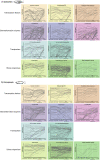The chemical defensome of five model teleost fish
- PMID: 34006915
- PMCID: PMC8131381
- DOI: 10.1038/s41598-021-89948-0
The chemical defensome of five model teleost fish
Abstract
How an organism copes with chemicals is largely determined by the genes and proteins that collectively function to defend against, detoxify and eliminate chemical stressors. This integrative network includes receptors and transcription factors, biotransformation enzymes, transporters, antioxidants, and metal- and heat-responsive genes, and is collectively known as the chemical defensome. Teleost fish is the largest group of vertebrate species and can provide valuable insights into the evolution and functional diversity of defensome genes. We have previously shown that the xenosensing pregnane x receptor (pxr, nr1i2) is lost in many teleost species, including Atlantic cod (Gadus morhua) and three-spined stickleback (Gasterosteus aculeatus), but it is not known if compensatory mechanisms or signaling pathways have evolved in its absence. In this study, we compared the genes comprising the chemical defensome of five fish species that span the teleosteii evolutionary branch often used as model species in toxicological studies and environmental monitoring programs: zebrafish (Danio rerio), medaka (Oryzias latipes), Atlantic killifish (Fundulus heteroclitus), Atlantic cod, and three-spined stickleback. Genome mining revealed evolved differences in the number and composition of defensome genes that can have implication for how these species sense and respond to environmental pollutants, but we did not observe any candidates of compensatory mechanisms or pathways in cod and stickleback in the absence of pxr. The results indicate that knowledge regarding the diversity and function of the defensome will be important for toxicological testing and risk assessment studies.
Conflict of interest statement
The authors declare no competing interests.
Figures




Similar articles
-
Independent losses of a xenobiotic receptor across teleost evolution.Sci Rep. 2018 Jul 10;8(1):10404. doi: 10.1038/s41598-018-28498-4. Sci Rep. 2018. PMID: 29991818 Free PMC article.
-
Comparative genomics and evolutionary diversification of the duplicated fabp6a and fabp6b genes in medaka and three-spined stickleback.Comp Biochem Physiol Part D Genomics Proteomics. 2012 Dec;7(4):311-21. doi: 10.1016/j.cbd.2012.10.001. Epub 2012 Oct 10. Comp Biochem Physiol Part D Genomics Proteomics. 2012. PMID: 23123309
-
Comparative evolutionary genomics of medaka and three-spined stickleback fabp2a and fabp2b genes with fabp2 of zebrafish.Genome. 2013 Jan;56(1):27-37. doi: 10.1139/gen-2012-0140. Epub 2013 Jan 1. Genome. 2013. PMID: 23379336
-
The taste system of small fish species.Biosci Biotechnol Biochem. 2015;79(7):1039-43. doi: 10.1080/09168451.2015.1023251. Epub 2015 Mar 17. Biosci Biotechnol Biochem. 2015. PMID: 25776867 Review.
-
Identification of olfactory receptor genes in Atlantic salmon Salmo salar.J Fish Biol. 2012 Jul;81(2):559-75. doi: 10.1111/j.1095-8649.2012.03368.x. J Fish Biol. 2012. PMID: 22803724 Review.
Cited by
-
A genome assembly of the Atlantic chub mackerel (Scomber colias): a valuable teleost fishing resource.GigaByte. 2022 Feb 14;2022:gigabyte40. doi: 10.46471/gigabyte.40. eCollection 2022. GigaByte. 2022. PMID: 36824513 Free PMC article.
-
A Chromosome-level Genome Assembly of the Highly Heterozygous Sea Urchin Echinometra sp. EZ Reveals Adaptation in the Regulatory Regions of Stress Response Genes.Genome Biol Evol. 2022 Oct 7;14(10):evac144. doi: 10.1093/gbe/evac144. Genome Biol Evol. 2022. PMID: 36161313 Free PMC article.
-
Biomarker selection depends on gene function and organ: the case of the cytochrome P450 family genes in freshwater fish exposed to chronic pollution.PeerJ. 2024 Feb 14;12:e16925. doi: 10.7717/peerj.16925. eCollection 2024. PeerJ. 2024. PMID: 38371375 Free PMC article.
-
Many human pharmaceuticals are weak inhibitors of the cytochrome P450 system in rainbow trout (Oncorhynchus mykiss) liver S9 fractions.Front Toxicol. 2024 Jul 15;6:1406942. doi: 10.3389/ftox.2024.1406942. eCollection 2024. Front Toxicol. 2024. PMID: 39077557 Free PMC article.
-
Comparative characterization of organ-specific phase I and II biotransformation enzyme kinetics in salmonid S9 sub-cellular fractions and cell lines.Cell Biol Toxicol. 2025 Jan 28;41(1):37. doi: 10.1007/s10565-025-09992-8. Cell Biol Toxicol. 2025. PMID: 39873933 Free PMC article.
References
-
- Stegeman, J. J., Goldstone, J. V. & Hahn, M. E. in Fish physiology: Zebrafish Ch. 10, (Elsevier, 2010).
Publication types
MeSH terms
Substances
Grants and funding
LinkOut - more resources
Full Text Sources
Other Literature Sources
Molecular Biology Databases

